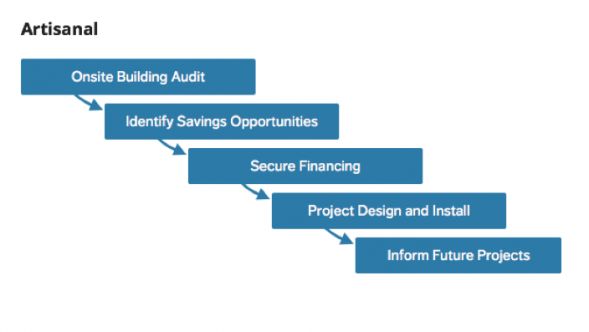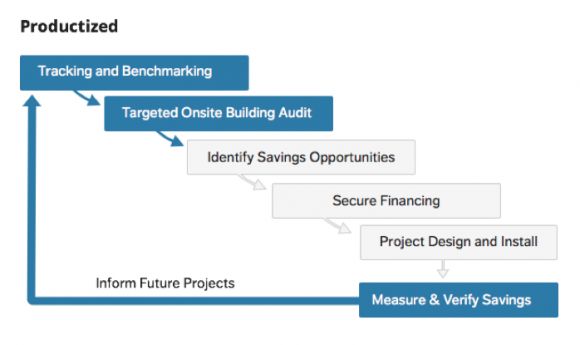The past few years have seen an abundance of software innovations designed to enhance the efficiency of the built environment. Taking advantage of inexpensive computing power and storage, these platforms are leveraging the torrent of data generated by and about our buildings.
But the analytics marketplace of today is like a crowded bazaar where vendors busily hawk their wares and shout hyperbolic pitches at passing customers. Although there is a lot of excitement in the air, there is also a lot of confusion about what these products can do and how best to deploy them.
The field is fast-moving, analytics platforms are still evolving with varying data and process standards, and economic value is not always easy to connect to realized building improvements. A previous piece argued that the efficiency industry must engage with building owners in a real estate management context in order to expand efficiency undertakings. This follow-up piece provides an overview of the efficiency market and its evolution over time. We then explore routes for the efficiency market to scale by moving from a process-step approach to adopting new structures that consistently deliver value to underlying building assets.
It is helpful first to understand where the building performance industry was centered just a few years ago. In the artisanal model, efficiency undertakings relied heavily on expert judgments, starting with onsite building audits.
Time-consuming and labor-intensive physical assessments uncovered building deficiencies, and savings potential was estimated through equally involved modeling exercises. This approach was widely accepted as the most thorough way to qualify and finance building upgrades. Utilities, efficiency program administrators, energy service providers, ESCOs and even software companies grew out of this business model.

With artisanal products, quality is usually exceptional, but volume is typically low and price is high. There also may be little consistency among products. Good audits require good auditors, and skill and experience levels can vary greatly from firm to firm and person to person. This traditional workflow is also a challenge to scale.
If you are an owner with a large portfolio of buildings, conducting an audit of every building is cost-prohibitive. How then does one decide which buildings should undergo this process?
A building audit is a one-time inspection, yet building performance is a dynamic system always responding to changing conditions. How does one know if an upgrade is performing as expected over time? How does one maintain data consistency and integrity among buildings and projects across different auditors and contractors?
The industry has a difficult time amassing enough data to inform future upgrades with sufficient degree of analytical rigor. Knowledge often resides within individual practitioners rather than being embedded within the system itself. An artisanal product is not always desirable.
Today’s productized framework builds on the artisanal approach but includes the step of tracking and benchmarking buildings before undertaking any physical assessments. This may involve accessing interval meter data, or, for buildings without those resources, analyzing monthly utility bills. (We’ve focused on the latter at WegoWise to reach the vast but underserved market segments of apartments, affordable housing, and smaller commercial buildings that may not have an interval metering infrastructure.)
Much of the analysis is now embedded in data platforms (i.e., productized) for greater consistency and scalability in uncovering efficiency opportunities.

Based on the initial tracking and benchmarking, one can prioritize onsite audits and physical assessments for assets performing below their peers, thus increasing owners’ confidence that savings will be uncovered. Critically, the days of simply assuming deemed savings are numbered; these new data platforms help auditors more quickly identify underperforming systems and end-use loads.
Building owners can deploy capital-improvement dollars in a more targeted manner, and after upgrades, they and their lenders can expect more robust measurement and verification protocols. This holds the auditors and contractors accountable for their work and also leads to better-informed future projects. Many of today’s leading energy service providers and building efficiency consultants have adopted this productized tool set.
But even with this enhanced workflow, deficiencies still exist. Owners understandably tend to undertake projects with easy savings, but often they may inadvertently still be left with a building that is not performing at its potential. Building owners are left in the frustrating situation of experiencing famine in a market of plenty; they are surrounded by innovative products yet are starved when it comes to clearly understanding and deploying proven and scalable solutions with confidence.
Most importantly, building efficiency continues to be a distinct activity from the core real estate management business. Far too often, it still takes a major mechanical breakdown, envelope failure or opportunistic incentives like rebates and tax credits to prompt owners to pay attention.
With the integrated framework, we propose refocusing attention on what really matters to the real estate industry: owning and operating high-yielding assets.

Property owners and managers have long adopted systems to manage activities like leasing, tenant screening, occupancy yields, maintenance schedules and finances. The key commonality among these systems is the level at which they operate: the real estate industry views performance across a portfolio of buildings.
That portfolio will contain assets with varying physical and fiscal characteristics. Owners and managers deploy information technology in order to consistently track metrics across these assets to improve individual asset performance toward the goal of optimizing the portfolio as a whole.
The essential aspect of the integrated approach then, is to deploy a portfolio management platform that serves as an overarching layer to bridge building efficiency and investment return. This platform will collect and analyze data ranging from utility consumption and weather patterns to pricing and regulatory changes. The information flow will create and update building performance profiles to enable a clear understanding of risk and reward for today’s tasks and tomorrow’s plans. Owners can prioritize upgrade investments across a portfolio of buildings within the context of all the operational expenses.
Consider that a one-time benchmarking exercise or an onsite audit is only a snapshot of a building’s performance and cannot capture the dynamic responses of a building. Therefore, this portfolio management platform must provide continuous tracking and benchmarking so that profiles are always up to date as the buildings’ physical systems evolve and external factors like weather and utility prices change.
As upgrade opportunities are broadly identified through universally available monthly data, additional analyses leveraging interval data can provide various levels of data granularity to optimize building operations or provide a remote audit of building and equipment conditions. Qualified building engineers can then further confirm savings opportunities through highly targeted and consistently protocoled onsite assessments.
Then, as owners upgrade buildings, the integrated framework captures that data to update the building profiles and verify performance. Shared feedback loops connect with additional analytics, financing, insurance and compliance regulations for a comprehensive real-time portfolio overview. With this complete picture, we can at last reduce complex technical choices into actionable investment decisions, helping managers to embrace an efficiency strategy that drives whole building improvements while optimizing overall portfolio performance.
This type of dynamic system monitoring has remade sectors like manufacturing, supply chain and retail -- helping to optimize operations and drive superior financial returns.
Why should the real estate industry accept any less? Today’s new wave of building data analytics promises to catalyze a similar transformation for building efficiency.
***
Andrew Chen is CEO of WegoWise, a leading provider of utility intelligence focused on multifamily buildings.



